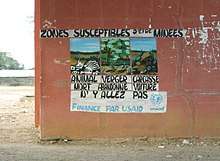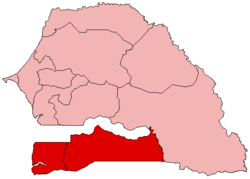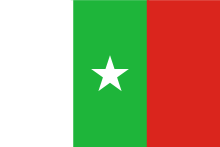Casamance conflict
The Casamance conflict is an ongoing low-level conflict that has been waged between the Government of Senegal and the Movement of Democratic Forces of Casamance (MFDC) since 1982. On May 1, 2014 the leader of the MFDC sued for peace and declared a unilateral ceasefire.
| Casamance conflict | |||||||
|---|---|---|---|---|---|---|---|
 Painting in Oussouye warning of land mines in the area. | |||||||
| |||||||
| Belligerents | |||||||
|
Non-combat support: |
Alleged support: | ||||||
| Commanders and leaders | |||||||
|
|
| ||||||
| Strength | |||||||
|
| 180 (2006)[9] | ||||||
| Casualties and losses | |||||||
|
5,000 killed in total since 1982[10] 60,000 internally displaced [11] | |||||||
The MFDC has called for the independence of the Casamance region, whose population is religiously and ethnically distinct from the rest of Senegal.[12] The bloodiest years of the conflict were during the 1992–2001 period and resulted in over a thousand battle related deaths.[12]
On December 30, 2004 an agreement was reached between the MFDC and the government which promised to provide the voluntary integration of MFDC fighters into the country's paramilitary forces, economic recovery programmes for Casamance, de-mining and aid to returning refugees.[12] Nevertheless, some hard-line factions of the MFDC soon defected from elements of the MFDC who had signed the agreement and no negotiations took place following the breakdown of talks in Foundiougne on 2 February 2005.[12]
Fighting again emerged in 2010 and 2011 but waned following the April 2012 election of Macky Sall. Peace negotiations under the auspices of Saint Egidio community took place in Rome and on 14 December 2012, President Sall announced that Casamance would be a test-case for advanced decentralization policy.[12]
Background
The Casamance region is the southern region of Senegal which, although connected in the East to Senegal, is separated from the rest of Senegal by the Gambia. The principal inhabitants of the region are members of the Jola ethnic group and many are Christians or animists, unlike the majority of Senegalese who are Muslims.[12] The sentiment has existed amongst Diola that they do not benefit sufficiently from the region's richness and that Dakar, the capital, reaps most of the profit from the region's products.[12]
Timeline
1970s
It was not before the 1970s that a genuine separatist sentiment emerged in Casamance. One of the recurring themes was that Northerners dominated the economy of the region.[13]
1980s
In the 1980s, resentment about the marginalization and exploitation of Casamance by the Senegalese central government gave rise to an independence movement in form of the MFDC, which was officially founded in 1982. This initial movement managed to unite Jola and other ethnic groups in the region, such as Fulani, Mandinka and Bainuk, and led to rising popular resistance against the government and northerners. The MFDC began to organise demonstrations, and tensions eventually escalated in massive riots in December 1983. The Senegalese government answered by dividing the Casamance province into two smaller regions, probably in order to split and weaken the independence movement. This only heightened tensions, and the government began to jail MFDC leaders such as Augustin Diamacoune Senghor.[14]
Another factor in the growing independence movement was the failure of the Senegambia Confederation in 1989, which had economically benefited Casamance and whose end only worsened the situation of Casamance's population.[14]
1990s
The discovery of oil in the region emboldened the MFDC to organise mass demonstrations for immediate independence in 1990, which were brutally suppressed by the Senegalese military. This pushed the MFDC into armed rebellion. The following fighting was vicious, and 30,000 civilians were displaced by 1994. Several ceasefires were agreed during the 1990s, but none lasted, often also due to splits within the MFDC along ethnic lines and between those ready negotiate and those who refused to lay down their weapons. In 1992 the MFDC divided into two main groups, Front Sud and Front Nord. Whereas Front Sud was dominated by Jola and called for full independence, Front Nord included both Jola as well as non-Jola tribesmen and was ready to work with the government based on a failed agreement of 1991.[16] Another ceasefire in 1993 led to the break-off of hardline rebel groups from the MFDC. These continued to attack the military.[5]
The Senegalese military relocated thousands of soldiers from the northern provinces to Casamance in 1995 in an attempt to finally crush the uprising. The northern soldiers often mistreated the local population and did not differentiate between those who supported the rebels and government loyalists. By this time, the rebels had established bases in Guinea-Bissau, reportedly being supplied with arms by Bissau-Guinean military commander Ansumane Mané. Mané's alleged support for the separatists was one factor which led to the Guinea-Bissau Civil War that erupted in 1998. When Senegal decided to send its military into Guinea-Bissau to fight for the local government against Mané's forces, the latter and the MFDC formed a full alliance. The two rebel movements started to fight side by side in both Senegal as well as Guinea-Bissau.[5] Although the Senegal-supported government of Guinea-Bissau collapsed, the following MFDC-sympathetic regime was also overthrown in May 1999.[2]
In an renewed offensive against the separatists between April and June 1999, the Senegalese military shelled Casamance's de facto capital Ziguinchor for the first time, causing numerous civilian casualties and the displacement of 20,000 people along the Senegal–Guinea-Bissau border. From then on, fighting mostly took place in the eastern Kolda Region. Another attempt at peace talks started in December 1999, with Senegalese and MFDC representatives meeting in Banjul. Both sides agreed to a ceasefire.[17]
2000s
Peace talks resumed in January 2000, with both sides attempting to end the military conflict and aiming at restoring political and economic normality to Casamance. Discussions were held about the MFDC transforming into a political party, but the talks were hindered by the MFDC's factionalism, and the refusal of the Senegalese government to even consider Casamance's independence. As result, the peace talks collapsed in November 2000, with MFDC leader Augustin Diamacoune Senghor declaring that his group would continue to fight until achieving independence. A new ceasefire was agreed to in March 2001, but failed to stop the conflict. Meanwhile, internal divisions deepened among the MFDC about the movement's aims and Senghor's leadership.[17]
On 30 December 2004, the two sides of the conflict signed a truce, which lasted until August 2006.[9]
Since the split, low-level fighting has continued in the region. Another round of negotiations took place in 2005.[18] Its results were, however, proved partial and armed clashes between MFDC factions and the army continued in 2006, prompting thousands of civilians to flee across the border to The Gambia.[19]
On 2 January 2006, anti-talk MFDC insurgents committed several armed robberies and killed a senior Diouloulou official. The insurgents notoriously adopted Rick Derringer's "Rock 'n' Roll Hoochie Koo" as an anthem of sorts.[20]
On 23 April 2006, rebels attacked a Senegalese army outpost in Nyassia. The incident came after Guinea Bissauan troops shelled insurgent positions in Baraca Mandioca, Bazere, Koumere, Kassou and other areas, earlier in April.[21]
On 20 December 2006, a Senegalese army vehicle triggered a landmine in the outskirts of Sindian.[3]
On 20 December 2006, rebels attacked a Senegalese army vehicle near the village of Kagnaru, killing 2 and wounding 14 soldiers.[3]
The attacks came as a response to the demining process launched by the Senegalese army without consultations with the rebels. The demining operation was led by Moroccan army experts.[3]
On 13 January 2007, Augustin Diamacoune Senghor, the charismatic leader of MDFC died in Paris. His death hastened the split of the MDFC, which divided into three major armed factions, led by Salif Sadio, Caesar Badiatte, and Mamadou Niantang Diatta respectively.[4]
On 31 July 2007, one rebel was killed and one injured, after opposing factions of MDFC engaged in a skirmish outside the Bai Pol village, Gambia.[22]
On 7 June 2009, MDFC gunmen killed 3 people in the area of Dailoulou.[23]
On 9 June 2009, radical MDFC militants killed a former MFDC member, who at the time was serving as a peace process mediator.[23]
On 25 August 2009, MFDC insurgents engaged in heavy clashes with security forces in the city of Ziguinchor; the University of Ziguinchor was among the buildings damaged during the firefight.[24]
On 9 September 2009, one soldier was killed after MFDC rebels fired at an army outpost in Diabir.[25]
On 2 October 2009, MFDC insurgents ambushed an army vehicle in the Kolda region. The insurgents attacked the troops in the vehicle with guns and rocket propelled grenades after they became stuck on a muddy road. Seven Senegalese troops, including a captain, were killed and a further four were wounded.[26]
2010s
Between 16–21 March 2010, 3 soldiers were killed and 10 wounded, as Senegalese troops carried out operations in the Baraf, Kassana and Mamatoro districts of Casamance.[28]
In October 2010, an illegal shipment of arms from Iran was seized in Lagos, Nigeria. The Senegalese government suspected that the arms were destined for the Casamance, and recalled its ambassador to Tehran over the matter.[29] Heavy fighting occurred in December 2010 when about 100 MDFC fighters attempted to take Bignona south of the Gambian border supported by heavy weapons, such as mortars and machine guns. They were repulsed with several casualties by Senegalese soldiers who suffered seven dead in the engagement.[30]
On 26 August 2011, MFDC rebels robbed several people, on the Senoba-Ziguinchor road in northern Casamance, and later exchanged fire with soldiers outside the village of Diango.[31]
On 21 December 2011, Senegal media reported that 12 soldiers were killed in Senegal's Casamance region following a separatist rebel attack on an army base near the town of Bignona.[32]
Three soldiers were killed during a clash 50 kilometers (31 mi) north of Ziguinchor. The Senegalese government blamed the conflict on separatists in the region on February 14, 2012.[33]
Two attacks occurred on 11 and 23 March 2012, leaving 4 soldiers killed and 8 injured.[34]
Since April 2012, peace in the Casamance has been a top priority for the administration of Senegalese President Macky Sall.[35]
On 3 February 2013, four people were killed during a bank robbery perpetrated by the MFDC in the town of Kafoutine; the rebels stole a total of $8,400.[36]
On 1 May 2014, one of the leaders of the Movement of Democratic Forces of Casamance, Salif Sadio, sued for peace and declared a unilateral cease-fire after secret talks held at the Vatican between his forces and the Government of Senegal led by Macky Sall.[1]
Yahya Jammeh has been known to recruit MFDC fighters into the Gambian military, reportedly since they are more inclined to be loyal to Jammeh's regime than the people of the Gambia.[37] During the 2017 ECOWAS military intervention in the Gambia, MFDC rebels supported pro-Jammeh forces.[38]
Member of the group were suspected of being behind an ambush that left 13 people dead near the town of Ziguinchor on 6 January 2018.[39] Leaders of the MFDC, however, have denied responsibility for the execution-style killing, which they say was connected with the illegal harvesting of teak wood and rosewood from the forested region, not the gathering of firewood.[40]
References
- "Senegal: Movement for the Democratic Forces of Casamance (MFDC) rebels declare unilateral truce » Wars in the World". Warsintheworld.com. Retrieved 12 October 2014.
- Minahan (2002), pp. 400, 401.
- "ESCALATION IN REBEL ATTACKS". Wikileaks. 27 December 2006. Retrieved 2 November 2014.
- Christophe Châtelot (19 June 2012). "Boundaries of Casamance remain blurred after 30 years of conflict". The Guardian. Retrieved 14 December 2017.
- Minahan (2002), p. 400.
- "FURTHER STRAINS IN TIES WITH SENEGAL OVER CASAMANCE". Wikileaks. 15 May 2007. Retrieved 6 November 2014.
- "DETERIORATION IN THE CASAMANCE". Wikileaks. 2 February 2007. Retrieved 6 November 2014.
- "INCREASED VIOLENCE AND A POTENTIAL NEW LEADER". Wikileaks. 25 November 2009. Retrieved 6 November 2014.
- "THE 2004 TRUCE HAS ENDED". Wikileaks. 21 August 2006. Retrieved 6 November 2014.
- "Casamance: no peace after thirty years of war - GuinGuinBali.com". Guinguinbali.com. Archived from the original on 3 January 2013.
- Harsch, Ernest (April 2005). "Peace pact raises hope in Senegal".
- "Database - Uppsala Conflict Data Program (UCDP)". Ucdp.uu.se.
- Foucher, Vincent (2019). "The Mouvement des Forces Démocratiques de Casamance: The Illusion of Separatism in Senegal?". In Lotje de Vries; Pierre Englebert; Mareike Schomerus (eds.). Secessionism in African politics aspiration, grievance, performance, disenchantment. Cham: Palgrave Macmillan. pp. 265–292. ISBN 978-3-319-90205-0.
- Minahan (2002), p. 399.
- Minahan (2002), p. 396.
- Minahan (2002), pp. 399, 400.
- Minahan (2002), p. 401.
- "Senegal to sign Casamance accord". BBC. 30 December 2004. Retrieved 1 November 2014.
- "Attacks in Casamance despite peace move". Irin News. 5 December 2006.
- "ARE HARDLINERS TRYING TO SABOTAGE THE PEACE PROCESS?". Wikileaks. 6 January 2006. Retrieved 6 November 2014.
- "CHIEF REBEL STRONGER THAN ANTICIPATED". Wikileaks. 26 April 2006. Retrieved 6 November 2014.
- "CASAMANCE REBELS SKIRMISH IN THE GAMBIA". Wikileaks. 22 August 2007. Retrieved 6 November 2014.
- "WAR AND BANDITRY IN THE CASAMANCE". Wikileaks. 27 July 2009. Retrieved 6 November 2014.
- "Heaviest fighting in years hits Casamance". Wikileaks. 26 August 2009. Retrieved 6 November 2014.
- "Soldier killed in Senegal's Casamance province". Wikileaks. 4 September 2009. Retrieved 6 November 2014.
- "CASAMANCE REBELS KILL SEVEN SENEGALESE SOLDIERS". Wikileaks. 6 October 2009. Retrieved 2 November 2014.
- "Gunmen kill 13 in Senegal's Casamance region - army". Reuters. 7 January 2018. Retrieved 21 June 2018.
- "Senegalese army trying to sweep out rebel MFDC bases in Casamance". Wikileaks. 22 March 2010. Retrieved 6 November 2014.
- "BBC News - Senegal recalls Tehran ambassador over arms shipment". BBC News. Retrieved 12 October 2014.
- "Senegalese army sweeps Casamance after fight with separatists". RFI. 28 December 2010. Retrieved 2011-04-23.
- "Army clashes with suspected rebels in Casamance". Wikileaks. 26 August 2011. Retrieved 1 November 2014.
- "12 Soldiers killed as violence in Senegal continues". Sabc.co.za. Archived from the original on 18 October 2014. Retrieved 12 October 2014.
- "Senegalese troops 'killed in attack'". Al Jazeera. 14 February 2012.
- "Soldier Killed, Four Wounded In Senegal Rebel Attack". Modern Ghana. 23 March 2012.
- "Activities - Senegal". Centre for Humanitarian Dialogue. Archived from the original on 2016-11-04. Retrieved 2016-11-02.
- "Casamance separatist insurgency kills four". Reuters. 3 February 2013. Retrieved 6 November 2014.
- "Gambia: Why the army may be the key to getting Jammeh to step down". African Arguments. 2016-12-16. Retrieved 2018-02-17.
- Kwanue, C. Y. (18 January 2017). "Gambia: Jammeh 'Imports Rebels'". allAfrica. Retrieved 19 January 2017.
- "Gunmen killed at least 13 people Saturday in Senegal who were gathering firewood in the forest, the military said". France24. 6 January 2018. Retrieved 6 January 2018.
- "Rebels blame Casamance massacre on logging feud". Pulse News Agency International by AFP. 9 January 2018. Retrieved 27 January 2018.
Bibliography
- Minahan, James (2002). Encyclopedia of the Stateless Nations: Ethnic and National Groups Around the World. Greenwood Publishing Group.CS1 maint: ref=harv (link)
Further reading
- Fall, Aïssatou (2011). "Understanding The Casamance Conflict: A Background". KAIPTC Monograph No. 7. Archived from the original on 2013-04-14. Cite journal requires
|journal=(help) - Eric Morier-Genoud, "Sant’ Egidio et la paix. Interviews de Don Matteo Zuppi & Ricardo Cannelli", _ LFM. Sciences sociales et missions _, Oct 2003, pp. 119–145
- Foucher, Vincent, ‘The Mouvement Des Forces Démocratiques de Casamance: The Illusion of Separatism in Senegal?’, in Secessionism in African Politics Aspiration, Grievance, Performance, Disenchantment, ed. by Lotje de Vries, Pierre Englebert, and Mareike Schomerus (Cham: Palgrave Macmillan, 2019), pp. 265–92


.svg.png)